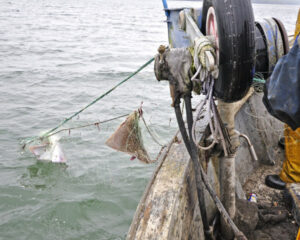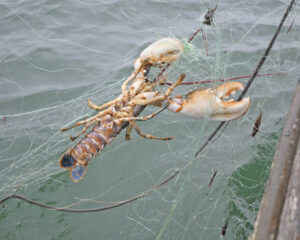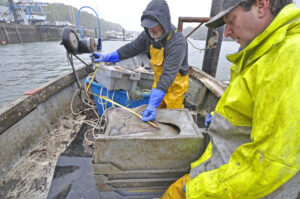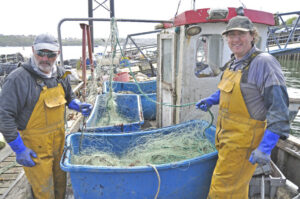John Worrall recently spent a morning with Welsh inshore skipper Steve De-Waine, netting for skate and rays from Neyland, on the Holton 24 Peter M
Now here’s a symptom of a wider condition.
Back in the 1970s and 1980s, there was a small deep-water fleet at Milford Haven: four or five trawlers and sidewinders, working out in the Channel, western approaches and Irish Sea, and getting a good return.
And then French pair-trawlers started to land, and the Milford boats faded away. Another factor was that European shellfish markets were opening up, and many local fishermen turned to potting, their catches collected by vivier lorries, bound mostly for Spain.

Steve (right) and Jeremy set about hauling rays (main image), which are soon coming up in numbers…
The pair teams have also gone now, although Spanish and Belgian beamers land regularly, to be met by trucks which collect their catches, to save them the steaming home. Local effort, meanwhile, still concentrates inshore, with potting of one sort or another at the heart of it. Most boats have either lobsters or whelks as their main focus, with prawns and occasional netting featuring for the smaller boats in this now mixed fishery.
Skipper Steve De-Waine works a Holton 24, Peter M CA 31, usually single-handed, out of Neyland, just along the coast from Milford Haven.
Peter M is one of two dozen or so boats, mostly under-10s, working from those two ports, and part of a wider inshore fleet operating from the small bays and harbours around the Pembrokeshire peninsula. It’s a coast which gets plenty of weather, but its sheltering headlands and inlets often allow some sort of fishing in all but the poorest conditions.
“Because I fish single-handed, I do a bit of everything. I work 140 lobster pots, 100 prawn pots, and 100 whelk pots, which, in poor weather, I can set in sheltered water. I vary the three through the year, with some netting in between,” says Steve.
“Lobsters start around February when we have a small run – if we can get out without losing the gear. They will generally slow down around May, and then come on again in the summer through to early autumn.
“Prawns run from about August to November. I can get my 100 prawn pots on the boat, so again, in poor weather, I can be up this sheltered end of the Haven, and down the other end when it’s better – and that also spreads the load on the ground.
“Brown crabs don’t feature much for me. I don’t process – some people do – which means mine have to go into storage pots. So it’s haul them out, put them in, haul them out… it’s a lot of heavy work. I’d rather land a box of lobster than five or six boxes of crab.”

… along with the occasional lobster.
Most shellfish, he says, still goes by vivier to Spain, although the whelks, like most whelks, finish up in Korea. Wet fish from the netting is bought by a merchant in Milford Haven. And the netting seems to be the glue that holds the wider fishery together.
“We shoot fixed nets for dogfish and mullet early in the season, and then perhaps from August to October. The whelkers here need the bait, and there are plenty of dogfish about. And we then get a bit of bass by-catch. We used to have a tidy little bass fishery here, but the EU stopped that. So we stay away from the main bass areas.
“Four or five times a year, we’ll net for rays, basically in the spring and on small tides, or when it’s too rough for lobstering. I generally shoot two or three bins, and lift them after two days.”
It was this part of his fishery that Fishing News had a look at in early May, heading down the Haven on Peter M for half a mile from the pontoon.
Steve has fished all his working life, starting part-time at 18 and going full-time in the early 1990s, always around south Pembrokeshire.
“I’ve had about eight different boats, from a small Cheetah cat through two Cygnus 32s, then a Kingfisher 24, and now I’m back on a Holton 24. For a short while with the Cheetah, I fished from Freshwater East, where there’s no dock and the boat went on a trailer. I’ve had Peter M for about five years.
“This is just a fun bit today,” he says, as we motor down in light but steady rain. And today, for a particular reason, he has help from Jeremy, now semi-retired, but until quite recently himself working mostly single-handed.
The hauling didn’t take long, and the nets, set flat on the bottom, produced over 100kg of thornback and a few lobsters, which was good enough for a couple of hours’ work. But it turns out that this is a fishery fighting for its life.
There is first a logistical problem. This part of Wales is some way from the big auction markets – it’s nearly five hours to Plymouth and Brixham – which means that the best wet fish prices aren’t always available.
“You can get your fish picked up and taken there for 20p a kilo, but you’ve still got to box it, and ice it, and wrap it in cling film. And then you have to have an agent down there to handle it, which all costs money.”

With the fish already taken to Welsh Seafoods in Milford Haven…
But he’s happy enough with the price from Welsh Seafoods Ltd in Milford. The bigger problems, he says, are diminishing fishing opportunity and a lack of government support.
“Firstly, we haven’t got quota, which makes it hard to justify spending money on wet fish gear. The only reason Wales has quota at all, following the 2012 Concordat that gave the four UK administrations more control over their fisheries, is that two Anglo-Spanish boats fish on licence in the Falklands and allow Wales to have some of their unused UK quota, which Wales then swaps for fish in Welsh sea areas.
“But then, of course, the quota system is based on track record, from a time when some people fishing today weren’t even born. So they haven’t got any. And many boats had been on shellfish, so they hadn’t got a track record either. And the recent bass restrictions and track record requirements won’t allow newcomers to get bass entitlement at all.”
And, he says, there is very little support from the Welsh government. “When the Welsh government took over from the two sea fisheries committees in 2010, they formed three inshore fisheries groups – north Wales, mid Wales and south Wales – to facilitate stakeholder engagement.
“But the geographical split for each group was wrong, because they didn’t understand the industry. And then they formed the Welsh Marine Fisheries Advisory Group, which became the main advisory group to the minister on policy.
“And the first thing that group did was to restrict fishermen’s input. We, at the West Wales Shellfishermen’s Association, fought for almost six years to try to get meetings papers to be circulated among fishermen prior to the meetings, and they wouldn’t do it. I wrote to each minister in turn – I think four – as they came into the job, to try to get them to resolve the issues, and they never did it.
“There are five or six fishermen’s associations in Wales, but the Welsh government isn’t using them.
“And then there’s financial support – EMFF and FLAGs – which is nowhere near as accessible as it is in England. And the operational programme, and the launch and communication for EMFF, has left a lot to
be desired.
“The fisheries minister, Lesley Griffiths AM, came to Pembrokeshire recently, and we took the opportunity to demonstrate. And because of that, we had a meeting with her and her officials in March. They said that the industry has the same access to funding as in England, but it doesn’t – though I do feel for the minister, as she clearly believes what her officials are telling her.
“Then the recent launch of the four Welsh FLAGs immediately led to industry disappointment, as again the operational programme differs from the other three administrations in the UK.

… it was back to sort the nets.
“The Welsh government made a decision that no project would be funded where tangible assets remained 12 months following the project end date, besides which the application process is very complicated and the guidance notes don’t fit. That’s not the case in England, and a quick look at the transparency tables for all four administrations in the UK tells a story.
“I sit on the Pembrokeshire FLAG, and we have members on two other FLAGs, and none of us knows what the money is going to be used for.”
All of this sounds frustrating and stressful – which then comes back to the reason Steve had Jeremy with him when Fishing News was aboard. Back in January, Steve was fishing single-handed and hauling pots, and started to feel unwell. Cutting the day short, he began to motor back, making a call to another boat on the way in, to tell the skipper what was happening. At the pontoon, the other fisherman called an ambulance. It took Steve to hospital, where he was told that, at the age of 52, as someone who cycles and goes to the gym, he’d had a heart attack.
He’s only now getting back to work, and daren’t go single-handed yet. “Fishing was once a carefree occupation, where all we had to worry about was the weather. Now it’s plagued with problems, all having a bearing on fishermen and creating STRESS!”








